When I was young, I was terrified of thunderstorms. Any time I saw the sky getting dark, I would high-tail it for the basement or hide under my covers.
Obviously, I’m over that now, or I wouldn’t be doing what I’m doing for a living.
Here’s what young Heather didn’t know: ominous black clouds don’t guarantee that a fierce storm is imminent, but they’re a pretty good clue. What really determines the appearance of a cloud is our angle to it and where the sun is in the sky, along with a few other things.
Clouds are made up of countless microscopic water droplets. Those droplets scatter incoming light from the sun so that only a small fraction of it reaches our eyes. The thicker the cloud, the darker it appears.
RELATED: How thunderstorms are like cookies
RELATED: How Lake Erie's 'shadow' works
Clouds with larger water droplets or clouds that are on the taller side scatter even more light and appear even darker. At the same time, those same clouds often bring severe storms, giving weight to the idea that a darker cloud means worse weather.
Clouds can also appear to have different hues, especially ahead of a really intense storm. Learn more about that in this week’s Heather’s Weather Whys.
New episodes of Heather’s Weather Whys are posted to the WGRZ YouTube channel every Wednesday evening.
If you have a weather question for Heather to answer, send it to her at heather.waldman@wgrz.com or connect with her on Facebook or Twitter.



